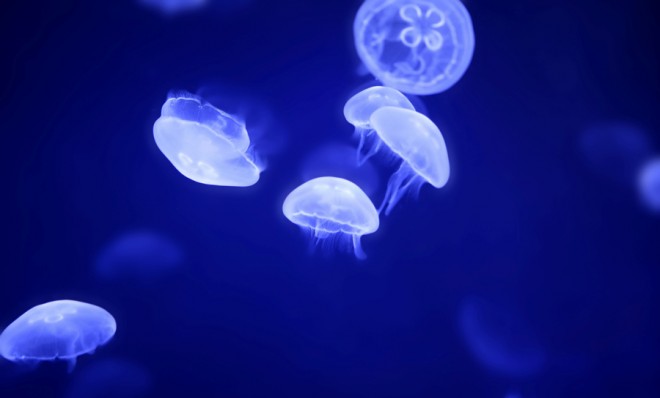5 scientific theories about what aliens might look like
Jellyfish? Bugs? Or just like you?


We've seen them portrayed in a vast variety of Hollywood films, from the nasty, slimy suckers shown in Independence Day to the precious, teddy-bear-esque creature that charmed us in E.T. But which is closer to the truth? As our understanding of the universe grows and the outlook on our existence is in turn humbled, scientists are beginning to theorize what these extraterrestrials might look like. While opinions can certainly vary (we all have them, no doubt), scientists are forming theirs on the basis of environmental and biological clues rather than science fiction. Does that mean we're closer to the answer? Of course not! Read on below to see the various forms of life scientists are predicting.
1. JELLYFISH
Dr Maggie Aderin-Pocock, who works for space firm Astrium, believes that aliens would be marine-type animals with "pulses of light for communication with other aliens, mouth type openings to scope chemicals from atmosphere for growth and reproduction, bodies that enlarge in sunlight, metallic surfaces for absorbing light, lenses for detailed viewing of their surroundings, orange undersides for camouflage, buoyancy sacks to maintain altitude." She bases this on her theory of how life began in the ocean here on earth and draws the conclusion that creatures could interact with a foreign atmosphere the same way organisms in our oceans interact with water.
The Week
Escape your echo chamber. Get the facts behind the news, plus analysis from multiple perspectives.

Sign up for The Week's Free Newsletters
From our morning news briefing to a weekly Good News Newsletter, get the best of The Week delivered directly to your inbox.
From our morning news briefing to a weekly Good News Newsletter, get the best of The Week delivered directly to your inbox.
2. BUGS
Cockroaches are among our planet's most indestructible creatures thanks to their thick exoskeleton, able to survive a very large range of intense conditions (including, some say, nuclear war). This makes a bug-style life form (intelligent or not) with strong armor a good bet when it comes to the myriad of environments which our universe contains.
3. JUST LIKE HUMANS
Simon Conway Morris, professor of evolutionary paleobiology at Cambridge University, thinks that aliens would be "just like humans," not only in appearance and biology but in weaknesses, such as "greed, violence and a tendency to exploit others' resources."
A free daily email with the biggest news stories of the day – and the best features from TheWeek.com
"My view is that Darwinian evolution is really quite predictable," Morris says, "and when you have a biosphere and evolution takes over, then common themes emerge and the same is true for intelligence."
Whether aliens being "just like us" would be a good thing or a bad thing is up for debate!
4. NON-CARBON LIFE
Based on what we know about life as it exists on Earth, it's understandable why many scientists, including Morris, would subscribe to the idea that aliens will look like humans. But while most of the life found on planet Earth is composed of carbon, hydrogen, nitrogen, oxygen, phosphorus, and sulfur, scientists found multicellular organisms that do not need oxygen back in 2010 (only bacteria were thought to have this trait prior). This obviously opened up a few questions about the way we view life and how it can exist. Scientific hypotheses exist today that suggest non-carbon based life could exist in the universe — the trendy pick is now silicon-based life forms — and if this turns out to be true, chances are that it would look nothing like that found on our planet.
5. CREATURES OF THE EXTREMES: DEEP SEA AND HIGH AIR
For example, in the Discovery Canada show Aliens: The Definitive Guide, Dr. Lewis Dartnell, an astrobiologist at University College London, laid out a few possibilities for aliens that might come from planets unlike our own. Creatures from "water worlds" might develop along the lines of the organisms we find in the bowels of our oceans, and a planet with a heavy gravity could support bigger, larger, and more powerful "flying creatures" that take advantage of the thick and dense atmosphere.
Have any ideas of your own about what E.T. might look like? Feel free to leave them in the comments below.
More from Mental Floss...
-
 Farage’s £9m windfall: will it smooth his path to power?
Farage’s £9m windfall: will it smooth his path to power?In Depth The record donation has come amidst rumours of collaboration with the Conservatives and allegations of racism in Farage's school days
-
 The issue dividing Israel: ultra-Orthodox draft dodgers
The issue dividing Israel: ultra-Orthodox draft dodgersIn the Spotlight A new bill has solidified the community’s ‘draft evasion’ stance, with this issue becoming the country’s ‘greatest internal security threat’
-
 Codeword: December 13, 2025
Codeword: December 13, 2025The daily codeword puzzle from The Week